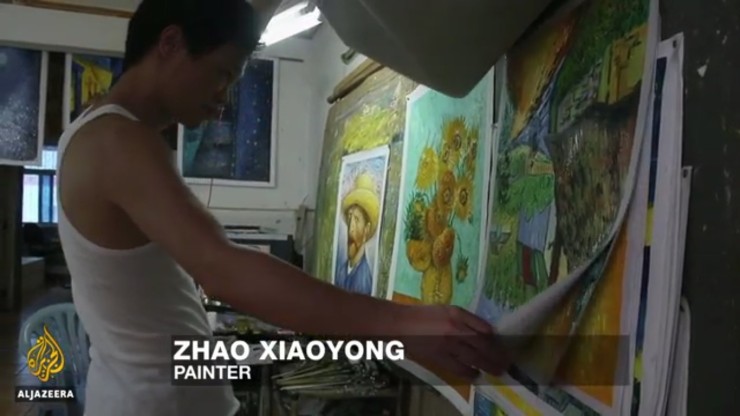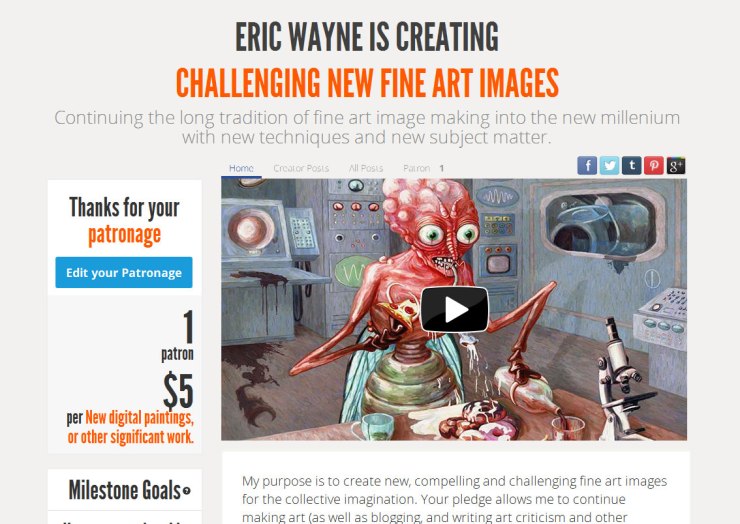
This poignant new documentary [which you can watch here] brings together two of my favorite things: Van Gogh and China. When I say China I’m talking about the everyday China that I lived in for over 4 years, and the good, hard-working people who live there: not the economic superpower or the communist government. Here we have an accurate glimpse into the life of an average Chinese citizen, coupled with the exultant vision of Van Gogh’s radiant canvases.
But it doesn’t stop there, folks, there’s a healthy dose of innocence, yearning, naivety, class difference, exploitation, and crushing reality. The (anti)hero here is a copy artist, named Zhao (Pronounced “Jao” which rhymes with “Pow”) who, with his family, has produced over 100,000 oil painted copies of Van Gogh’s works over 20 years, but lives in near poverty and dreams of seeing Vincent’s paintings in person.
SPOILER ALERT: If you are going to watch the film, and you are like me, in that you like suspense, than you may want to save reading any more until after you’ve seen it, at which time you might wanna’ compare notes and see if you agree with my idea of what Zhao can do with his dead-end career. That said, my internet crapped out with about a half hour left [it always goes out around lunch-time for a half hour or so], so nothing I am writing now will ruin the ending for you. For those that don’t mind knowing the bold outlines of what you’ll see, please read on.
One of the most fascinating lessons we see here is the difference between what one longs for and what it is, which is often disappointing as compared to what one had envisioned. Zhao, when he gets to Amsterdam, is surprised that it is such a small city without skyscrapers and enormous apartment complexes that start to resemble bee hives. This is because even a medium-sized city in China, that nobody outside of China has heard of, is a behemoth compared to famous cities in Europe.
Zhao only has a primary school education, and worked decades for a dealer in the Netherlands without ever discovering what his paintings sold for. When he eventually made it to Amsterdam he discovered his own paintings in a souvenir shop (not what he imagined), and selling for more than 10 times what he sold them for. He squatted on the pavement as the world pressed down on him, having finally reached the epicenter of his dreams only to be crushed by realities he didn’t fully understand. He has merely been used, along with his family. He is a factory worker in the developing world producing a painterly product for a first world marketer who takes over 90% of the proceeds.
His search for God is a search for Van Gogh, but Vincent is long gone, and when he reached the proverbial temple, he was turned away as a worthless beggar. He gave everything into the legend of Van Gogh and got back just enough to continue giving. I think most of us can relate to this a bit. I’ve had the insight (maybe you have as well) that while working full-time I was ultimately doing it just for the privilege of the ability to continue working full time. That’s the reward. You just get to keep going, making someone else more money than you make for yourself working for them.
But there is hope for the artist, Zhao, and here it is.
He has in fact been extraordinarily lucky to have been featured in this film. Now, the world knows who he is. If you haven’t watched the film already, when you do, and they show scenes, such as where his ancient mother resides, or the modest but monstrously huge city his lives in, notice how fantastic those landscapes would look if painted in the style of Van Gogh.
Realistically, he can’t paint like Van Gogh, and anyone with a good eye and honest appreciation of the Dutch artist would instantly realized Zhao’s paintings were fakes. [See my own fake Van Gogh tribute painting, done digitally no less, here.] Nevertheless, I believe he would quickly develop his own variant on Vincent’s style, freed from copying, by simply paintings his own surroundings, himself and his family. The night-time neon cityscapes are subjects Vincent never encountered, and Zhao could carry on the tradition of Van Gogh into 21st century China in such depictions.
Rather than imitate the paintings of Van Gogh, he should switch to imitating the artist himself more. Van Gogh didn’t just copy paintings (though he definitely learned from copying), he painted what was around him.
I think Zhao can easily make this transition, even if only part time while still churning out copies after the master. Rather than knocking out images as fast as possible, he could hunker down and try to fashion his own pearls. Galleries in China might like to sell their local Van Gogh, and galleries abroad could market the exoticism of everyday China.
But, why am I assuming this is an easy transition? I’ve always made my own art and find it tortuous to copy what someone else has done, though I also recognize it as an excellent exercise (I recently spent about 20 hours copy someone else’s digital painting by slowing down a video and replicating each action). If someone has never made their own imagery, can they switch over?
My internet is back on and now I can finish the documentary.
Zhao had the same realization in his own life that I had just from watching the film (minus that last half-hour), which is that he needed to make his own work. In the Van Gogh museum people asked him, right off – as a more individualistic Westerner would think to do – if he made his own work. He had not made a single independent painting in 20 years. Recalling this in a restaurant, while knocking back drinks, he asked if a painter can become an artist.
Oddly, I can envision being there with him and his family as I’ve had many such dinners in Chinese restaurants with Chinese people in untouristed cities while knocking back beers. At this same table it became evident again how much they love Van Gogh. It’s just one more touching scene because of how Vincent’s art has reached people more than a century after his death, in a part of the world where he would never and could never have imagined. Here, a struggling family not so unlike his Potato Eaters gathers, on the other half of the globe, around the topic of his art and his vision.
All of this, of course, is taking place long after painting was declared dead, in which case all the participants are reliving the past. On the other hand they are bringing the past back to life, but apparently oblivious to the teaming contemporary Chinese art scene.
In the end, Zhao makes a few original paintings, which are not bad but don’t look like Van Gogh went to China. They are interesting enough, however, to justify making a lot more.
Finally, he states that his original art may not be appreciated now, but perhaps in 50 or 100 years. Here we see the painter is still naive. Van Gogh was a pioneer, though people tend to appreciate him for all the drama surrounding his life and art. He made the process of painting, and the angles of strokes, highly prominent long before the Abstract Expressionists. His paintings packed more expressive power than any of the Expressionists, IMO. He fully appreciated that a painting was a kind of artifice, and its own reality, rather than just a replication of nature. Most significantly, he created his own system of representation which was a compromise between observable, quotidian reality, and his individual, inner, subjective vision. The result is highly personal, idiosyncratic paintings which also happened to explore territory where past methods and concepts had not.
Merely working in an approximation of his style does none of those things, but I think a Chinese painter who has been making copies of Van Gogh for 2 decades doing it is interesting. I’d surely hang one of his pieces in my home, or a cafe.
From the standpoint of the blue-chip art world anything Zhao does is dead on arrival. But for the rest of us a painting is like a meal, and it doesn’t need to be the latest recipe (which analogously may not be for human consumption to begin with) to give satisfaction and sustenance.
~ Ends
An independent artist and critic could use a hand. Through Patreon, you can give $1 (or more) per month to help keep me going (y’know, so I don’t have to put art back on the back-burner while I slog away at a full-time job). Ah, if only I could amass a few hundred dollars per month this way, I could focus entirely on my art and writing. See how it works here.
Or go directly to my account.
Or you can make a small, one time donation to help me keep on making art and blogging (and restore my faith in humanity simultaneously).
If an advertisement appears below, I have no control of it and get no proceeds.




What a sad story. What a hard worker too 100,000 copies over 2- years! Exploitation is exploitation whether you live in a capitalist or so-called “communist” system (I know China ceased being genuinely communist a long time ago).
LikeLiked by 1 person
I think the government is still communist, but the economic system has embraced Captilalism, and with all the early abuses of it. I lived in China for over 4 years so got to see it at work first hand. Chairman Mao would be rolling over in his grave like a rotiserie if he could see how the rich Chinese exploit the “peasant” class mercilessly.
It is a sad story, but I do really think the film may help to launch a more fulfilling career for Zhao making his own paintings. I sure hope so. Having lived and taught in China for so long, it’s a second home to me, and I have a fondness for Chinese people.
If you get a chance try to see a movie called. Beautiful Accident, which I saw on a plane. It’s a really nice depiction of the better values and humanity of the Chinese people.
LikeLike